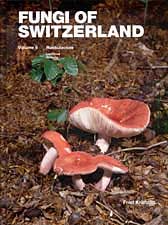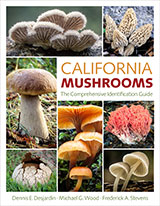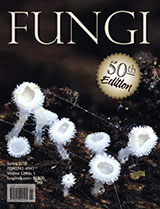Book Review
Fungi of Switzerland:
Vol. 6, Russulaceae
I began my review of Volume 5 in this series by saying, "There's both good news and bad news to report," and that's also true with respect to Volume 6. First the good news–the latest of the "Swiss books" is now available. The bad news is that it is the final volume of this fine project produced by a small group of Swiss amateur mycologists; there are no more to look forward to. Also in the bad news category is the fact that our dollar is not doing as well in late 2005 as it was in 2001 so, although the price for this volume is the same in Swiss francs as the last two, it will cost U.S. buyers about 25% more.

This is the last volume in a series that documents the macrofungi of Switzerland. The previous five volumes cover the larger ascomycetes (Vol.1); the non-gilled fungi—jellies, polypores, chanterelles, corals, puffballs, and the like (Vol. 2); the boletes and a portion of the agarics—Hygrophoraceae, Tricholomataceae, and gilled Polyporaceae (Vol. 3); another portion of the agarics—Entolomataceae, Pluteaceae, Amanitaceae, Agaricaceae, Coprinaceae, Bolbitiaceae, and Strophariaceae (Vol. 4); and the Cortinariaceae (Vol. 5). Coverage concludes here with the Russulaceae (Russula and Lactarius). Altogether, over 2,400 species are described and illustrated, including 218 in the last volume. The earlier volumes all have been praised for their high quality, and the new release does nothing to detract from the series's well deserved reputation.
The format is essentially the same as that of the earlier volumes. After the preface by mycologist Henri Clémençon, translators' note, and author's foreword, the book includes an introduction and synopsis of the taxonomic arrangement, spore-color chart, study methods, glossary, lists of abbreviations and symbols used, abbreviations of taxonomic authors' names, and both Latin and English names for the plants that appear in the habitat descriptions. This is followed by a set of dichotomous keys to the included taxa and the species descriptions. The book conludes with an extensive bibliography, index, and a cumulative appendix with keys, family and genus lists, and an index to the entire series.
The keys are based on a combination of macroscopic features and basic microscopic observations, such as spore shape, ornamentation, and dimensions. The floristic part represents the main body of the book, and it will look familiar to users of the previous volumes, with one major exception: Previously, species descriptions were arranged three per two-page spread, one above another. Here there are only two species per two-page spread. As usual, on the left-hand page is the fungus's name, including author, a short list of synonyms, a symbol denoting edibility, and the text description. Each description includes information about habitat; macroscopic features of the pileus, flesh, lamellae, and stipe; microscopic features; taxonomic remarks such as how to distinguish similar species; and source and date of the collection. On the right-hand page are clear line drawings of microscopic features including spores, basidia, cystidia, and pileipellis, and a high-quality color photograph, usually taken in situ so that visual information about habitat is conveyed. The spore-print color swatches used in Volume 4 have returned, given the importance of spore-print color in separating species within the Russulaceae.
This is a another very nicely produced book–highly informative, aesthetically pleasing, and useful for, as well as usable by, amateurs and professionals alike. At over $100 it isn't cheap; however, its high quality and value make it worth the price. If you're serious about identifying mushrooms, you'll find the set indispensable.
[Note: For those interested in filling in missing volumes in your collection, all are still available in English, German, or French at the following prices: Volume 1 (118 CHF), Volumes 2 and 3 (148 each), and Volumes 4 and 5 (158 each). Shipping is 23 CHF for the first book ordered, and 14 for each additional book. Visa and MasterCard accepted. Contact Verlag-Edition Mykologia Lucerne, P.O. Box, CH-6000 Lucerne 6, Switzerland.]
— Review by Steve Trudell, Seattle, WA
— Originally published in The Mycophile 47:4, 2006


